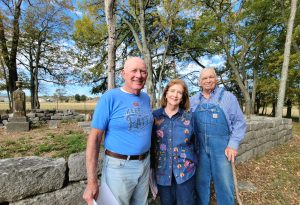
From left to right, Alvis Turrentine, Barbara Pate, and Bob Finney at Greer Cemetery.
By ZOË WATKINS
zwatkins@bedfordcountypost.com
Bob Finney brushed away dead leaves from a headstone buried beneath.
“This is another Greer wife,” he muttered. “Died 1843.”
Greer Cemetery is the oldest community cemeteries in Bedford County. When Finney first came across it over 30 years ago, it was shrouded in weeds, brush, and forgotten names.
“This cemetery adopted me,” Finney said, who does not have family buried there. But that hasn’t stopped him from dedicating his free time to cleaning up the sanctuary, located next to Sugar Creek off of Highway 130.
Finney along with Barbara Pate and Alvis Turrentine are working to revive the cemetery, which contains the remains of some of Bedford County’s first settlers—the Greers, Delks, Robinsons, Gaithers, Hastings, Chapmans, and Mortons. A few of the graves stretch back to before the county was established in 1807.
“As Bedford County is concerned…I think it’s really significant to think about the first settlers,” said Pate.
Pate and her late husband Russell have a small bit of annexed land next to Greer Cemetery where they will rest side-by-side. But she said she wants to see this historic community cemetery continued to be preserved.
They have already received approval to be added to the historical registry by the Tennessee Historical Commission, and they are in the process of applying for approval for the marker. But they will need to raise money to cover the cost.
“There’s still a lot of work left to do,” said Finney as he pointed to a large tree. Its roots has caused part of the limestone fence to fall apart. They will also be applying for a grant to restore the stone fence.
On one of the trees, barbed-wire juts out from its base, showing where wire was once used to keep in livestock, which damaged many of the stones. Finney has put together many of the stones like puzzles pieces.
First settlers
Alvis Turrentine has done much research on the Greers and their cemetery. He lives in a house that utilizes the 1948 remains of what was once Thomas Greer’s home.
After the Revolutionary War, North Carolina passed the Land Grab Act of 1783 which offered land in the Duck and Elk River watersheds to those who contributed to the war.
In 1783, Alexander Greer set out with some assistants to lay claim to some land. First coming to French Lick Station, later called Nashville, they came across the Elk Ridge (Chestnut Ridge) to a lick on a creek they called Lick Creek, now called Sugar Creek.
According to Turrentine, Alexander Greer acquired the southern tract of 5,000 acres which bordered the foot hills of Chestnut Ridge. The northern part, part which borders the current Highway 64, was given to his brother Thomas Greer.
Thomas Greer’s child was buried in what is now the Greer Cemetery as evidenced by a grave stone dated Sept. 6, 1805 making it the earliest known burial in Bedford County, according to county historian Tim Marsh, who studied the cemetery in the late 1970s.
The Greer Cemetery continued to become the burial place for many residents of Pleasant Grove. The head stones indicate that many of the Greer family died very young, with several infant and child burials prevalent.
“There were a lot of children that died in the cholera epidemic. A lot of them,” said Finney.
Others lived long lives, such as Thomas Greer, who was born in 1770 and died in 1848 at age 77, and his wife Catherine R. Greer who was born in 1781 and died in 1865 at age 84 years old. Many of these names have been recorded thanks to documentation done by Marsh in 1977.
But there are still many graves whose names have been lost to history.
The location of Alexander Greer’s tomb is unknown to Turrentine. But many of his descendants are buried in the Dyer Cemetery located just off of Sandusky Road.
Continued support
As part of their preservation plan, Pate said they are hoping to connect relatives with the many people buried at Greer as well as bring awareness to its historical significance.
As Pate and Finney walked through the cemetery, cut stones seemed to appear from beneath weeds and leaves while deep impressions in the ground toward the back of the cemetery indicate where graves once were.
Carrying a four-foot walking stick, Finney cleared off brush from another stone that was probably a foot stone.
“There’s a lot, and I’m not sure if they’re all unmarked graves or not,” he said.
“There’s a lot of unmarked graves. That one and that one,” he said, indicating plain square stones barely poking up from the grass.
But for those who know they have a relative buried in Greer, Pate is encouraging people to reach out to Turrentine to build up their network of connections. You can reach him at aturrentine@cafes.net.





![For-Tips-and-Ideas-Phone-300x250-Bedford-County-Post[1]](https://www.bedfordcountypost.com/wp-content/uploads/2023/09/For-Tips-and-Ideas-Phone-300x250-Bedford-County-Post1-300x250.jpg)
![Subscribe-Now-300x250-Bedford-County-Post[1]](https://www.bedfordcountypost.com/wp-content/uploads/2023/09/Subscribe-Now-300x250-Bedford-County-Post1-300x250.jpg)
